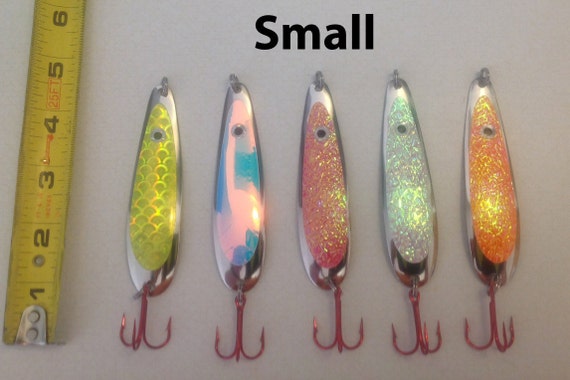

Small and medium-sized trout are often found in ripple areas and can offer fast, aggressive action.Run a size 1 – 4 Panther Martin Classic or FishSeeUV spinner across the leading edge of deep water before probing the center or tailwaters of such pools. Look for the biggest trout to hold in deep bends, runs and pools where water flows slower than in main channels.With slower current than other areas, trout fodder settles quickly settles to the bottom in these areas making them ideal feeding spots favored by medium to large trout. Identify deep, lunker holding pools by their smooth surface and dark complexion.They will hold some trout almost anytime during the day if there is sufficient cover. Runs are deeper than riffles with moderate current and a bottom consisting of small gravel or rubble.They produce best in the early morning and late evening. Riffles feature fast current and shallow water with rubble, gravel or boulders on the bottom.To maximize catches, note the water type holding the most fish and then concentrate your efforts on similar stretches. The currents in most streams create a repeating riffle-run-pool pattern.Try the various Panther Martin Spotted spinner combinations to discover your local trout codes. Classic color pairs include yellow/black, red/yellow and black/fluorescent. Most trout waters have a "secret combination" of colors that seem to always catch fish.Their holographic patterns and shimmering hammered brass blades reflect a lot of light, change colors in the water, and provoke vicious reaction strikes from fish looking for a last meal before sunset or the onset of foul weather. In low-light conditions or when fishing shadowed pocket water, Holy Hammered spinners make a great choice.They make a great starting point when fishing new or unfamiliar waters. Panther Martin All Gold (PMAG) and All Silver (PMAS) Classic Patterns in sizes 1 – 6 work for all species of trout under virtually any conditions.Use size 2 through 9 for deeper waters, longer casts or areas where large trout are known to lurk. Use size 1 and 2 Panther Martin spinners to work shallow waters and small trout streams.Bank fishermen should consider using waders or hip boots to increase access to productive water. Because trout can be especially wary, dress to blend in with shoreline brush and surroundings.Look for them to feed over sandy, gravel or smooth rock bottom in areas unobstructed by heavy weeds. Trout that live in lakes, ponds and slow-flowing waters prefer clear, open stretches.Begin your retrieve as the current swings the spinner into the strike zone.

For stream and river fishing in strong flows, be sure to quarter the current in an upstream direction with each cast.Panther Martin Holographic Red Hook spinners work especially well for brook trout, cutthroats, Arctic char and Dolly Varden. Silver spinner blades are known to excite rainbows, lake trout, cutthroats and brookies while brown, golden and bull trout often favor gold blades.Under most conditions when using spinners a simple, straight retrieve works best for trout.Look for them at the head of deep pools, in the shade of undercut banks, and in the shadows of large rocks, boulders, ledges and overhanging shoreline brush. At this point in the season trout hold in the coolest water they can find. Increase retrieval speed as waters warm with the advance of spring or cool off in early fall. Early and late in the season, when waters run coldest, a slow retrieve generally works best.Most species show a marked preference for Panther Martin Classic, Holographic and FishSeeUV in-line spinners. Trout respond quickly to intense colors, sonic vibrations and bright flash.That most species of trout show an exceptional fondness for in-line spinners - Panther Martins in particular. Although they can be caught on a wide variety of baits, lures and flies, we’re especially pleased to report Target them early or late in the day when possible, and approach quietly while keeping a low profile in your boat Rainbow, brown, lake, golden and cutthroat trout are typical representatives.Īlthough not truly trout, members of the char family including brookies, Dolly Varden and arctic char are often considered in thisĬategory due to their trout-like appearance, habitat requirements and feeding tendencies.Īs a rule, most trout species prefer cool waters, feed best during periods of low light intensity and have a strong tendency To supplement naturally reproducing native populations. They thrive in rivers, streams, lakes and ponds across the world and are often heavily stocked Relatively shy, challenging to catch and especially good eating, the various members of the trout family are among the most popular


 0 kommentar(er)
0 kommentar(er)
